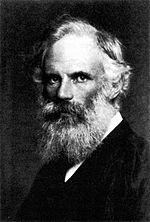George Francis FitzGerald facts for kids
Quick facts for kids
George Francis FitzGerald
|
|
|---|---|

George Francis FitzGerald
|
|
| Born | 3 August 1851 |
| Died | 22 February 1901 (aged 49) Dublin, Ireland
|
| Nationality | Irish |
| Alma mater | Trinity College, Dublin |
| Awards | Royal Medal (1899) |
| Scientific career | |
| Fields | Physics |
| Institutions | Trinity College, Dublin |
George Francis FitzGerald (born August 3, 1851 – died February 22, 1901) was an Irish scientist. He was a physics professor at Trinity College in Dublin, Ireland, during the late 1800s.
FitzGerald is famous for his work on how electricity and magnetism interact. He is also known for the idea of Lorentz–FitzGerald contraction. This idea later became a key part of Albert Einstein's special theory of relativity. A crater on the far side of the Moon is named after him. A building at Trinity College, Dublin also carries his name.
Contents
Early Life and Physics Career
George Francis FitzGerald was born in Dublin on August 3, 1851. His father, William FitzGerald, was a professor and later a bishop. George entered Trinity College as a student when he was 16 years old.
In 1877, he became a Fellow of Trinity College. He spent the rest of his career there. In 1881, he became the Erasmus Smith's Professor of Natural and Experimental Philosophy. This was a special title for a physics professor.
Working with Electromagnetic Theory
FitzGerald was a leading scientist who studied James Clerk Maxwell's theories. Maxwell's theories explained how electromagnetic fields work. FitzGerald, along with other scientists like Oliver Lodge and Heinrich Hertz, helped to improve and confirm these ideas.
In 1883, FitzGerald was the first to suggest a way to create electromagnetic waves. These are waves of energy, like radio waves. He thought of a device that could make fast-moving electric currents. Five years later, in 1888, Heinrich Hertz proved that these waves really existed through experiments.
Awards and Recognition
FitzGerald was recognized for his important work.
- In 1883, he was chosen as a Fellow of the Royal Society. This is a very respected group of scientists.
- In 1899, he received a Royal Medal for his studies in theoretical physics.
- In 1900, he was made an honorary member of the Royal Society of Edinburgh.
FitzGerald had health problems for much of his life. He died in Dublin on February 21, 1901, after an operation. He was buried in Mount Jerome cemetery.
The Length Contraction Idea
FitzGerald is best known for an idea he wrote about in 1889. He suggested that if objects moving very fast became shorter in the direction they were moving, it could explain a strange experiment. This experiment was called the Michelson–Morley experiment. It had surprising results that scientists couldn't explain.
FitzGerald's idea was based on how electromagnetic forces were affected by motion. He used equations from his friend, the engineer Oliver Heaviside. A Dutch physicist named Hendrik Lorentz came up with a similar idea in 1892. Lorentz developed it further into what are now called Lorentz transformations.
The Lorentz–FitzGerald contraction idea became a key part of Albert Einstein's Special Theory of Relativity. Einstein published his theory in 1905. He showed that this shortening effect happens because of how space and time are connected, especially at very high speeds.
Family Connections
FitzGerald married Harriette Mary Jellett in 1885. They had eight children together.
He was the nephew of George Johnstone Stoney, another Irish physicist. Stoney was the person who first used the word "electron." After these tiny particles were found in 1896, FitzGerald suggested that they should be called "electrons." FitzGerald was also the nephew of Bindon Blood Stoney, a famous Irish engineer. His cousin, Edith Anne Stoney, was also a pioneer in medical physics.
Flying Experiments
Like many people in the late 1800s, FitzGerald was very interested in flying. In 1895, he tried out flying experiments at Trinity College in Dublin. He used a Lilienthal glider. Many students helped by pulling ropes attached to the glider. People in Dublin watched these experiments with great interest.
FitzGerald would take off his coat for these experiments, but he always kept his top hat on. This was normal for a professor at that time. Sadly, his flying attempts were not successful. He eventually stopped the experiments. The glider hung in the Museum Building for many years after that.
See also
 In Spanish: George Francis FitzGerald para niños
In Spanish: George Francis FitzGerald para niños


